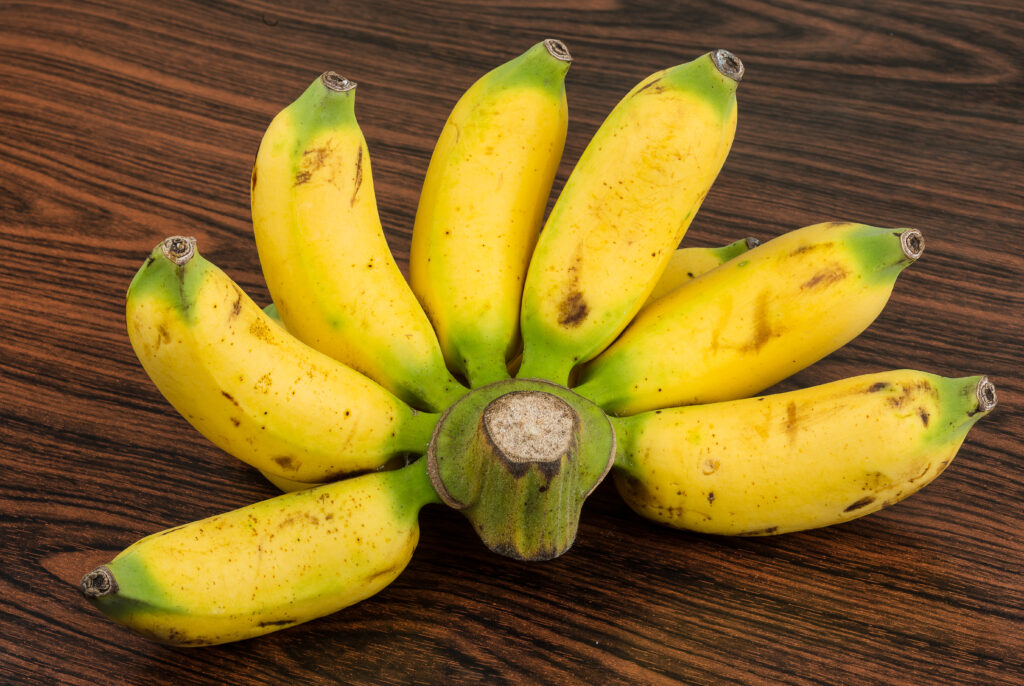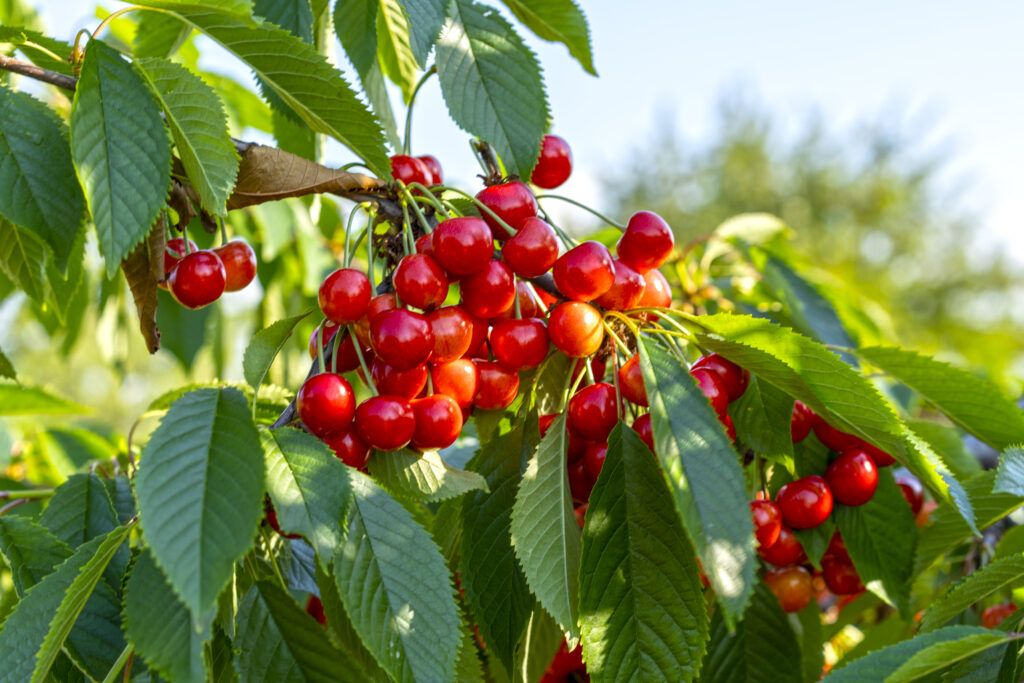Loquat Farming
The loquat (Eriobotrya japonica), an evergreen fruit tree native to southeastern China, is cherished for both its ornamental beauty and its clusters of golden-orange fruits, often referred to as “Japanese plums.” Its sweet-tart flavor is reminiscent of apricots and pineapple, with a tender, peach-like texture that makes it ideal for fresh consumption as well as use in jams, jellies, and desserts. Rich in vitamins A and C, antioxidants, and dietary fiber, loquats offer several health benefits, including improved skin health and vision, weight management support, regulation of blood pressure, enhanced circulation, and stronger teeth and bones.
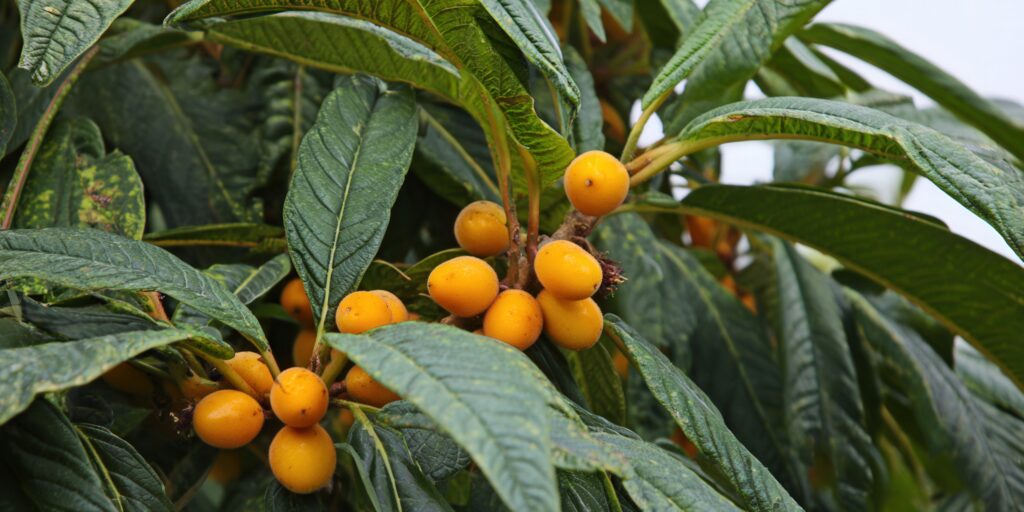
Loquat farming profit per acre can be highly rewarding when planned and managed effectively over time. The orchard generally reaches its break-even point by the seventh year, when cumulative income surpasses total investment. The peak earning period spans Years 7 to 15, generating approximately 72% of the total revenue.
With an initial setup cost of NRs 124,000 and annual maintenance expenses of NRs 50,000 over 24 years (totaling NRs 1,200,000), the total 25-year investment amounts to NRs 1,324,000. In comparison, total income can reach about NRs 5,279,680, resulting in a net profit of NRs 3,955,680. This translates to an average annual profit of roughly NRs 219,760 from Year 7 onward, demonstrating the long-term profitability and sustainability of loquat cultivation.
Land Preparation
Land preparation for loquat cultivation involves several essential steps to ensure optimal soil conditions. Begin by clearing the area of all vegetation, rocks, and debris. Deep plowing to a depth of 45–60 cm helps break up hardpans, improving soil aeration and drainage—critical since loquat trees are sensitive to waterlogging. After plowing, harrowing is carried out to break down soil clods, level the land, and achieve a fine tilth suitable for planting.
In sloped areas exceeding a 10% gradient, contour terraces or basins should be constructed to minimize soil erosion and enhance water retention. Finally, for nutrient-deficient soils, 10–15 tonnes of well-rotted farmyard manure (FYM) or compost per acre should be incorporated during the final harrowing to enrich soil fertility.
Soil Type
Loquat thrives best in deep, well-drained loamy soils—such as sandy loam or clay loams that are rich in organic matter, with good internal drainage being crucial for healthy root development. The ideal soil pH ranges from 6.0 to 7.5, though the plant can tolerate a broader range of 5.5 to 8.5; however, extreme pH levels, particularly above 7.5, may lead to nutrient imbalances like iron chlorosis.
Heavy clay soils with poor drainage, excessively sandy soils with low moisture and nutrient retention, saline soils, and waterlogged areas should be strictly avoided to prevent stunted growth and poor fruit yield.
Climatic Requirements
| Factor | Specific Condition | Requirement/Effect |
| Temperature | Overall Range | Subtropical to mild temperate. Thrives at 10°C – 30°C (50°F – 86°F). |
| Optimal Growth | 18°C – 25°C (64°F – 77°F). | |
| Flower Bud Initiation | Requires cool (non-freezing) temperatures in autumn/winter. | |
| Frost Tolerance (Dormant) | Mature trees tolerate brief dips to -10°C (14°F). | |
| Frost Damage (Flowers/Fruit) | Highly damaging. Flowers/fruit die around -3°C (27°F). | |
| High Summer Heat | >35°C (95°F) can cause sunburn on fruit and leaves. | |
| Rainfall | Annual Amount | Moderate: 900-1200 mm annually. |
| Distribution | Well-distributed, especially critical during fruit development. | |
| Drought Tolerance | Tolerant once established, but irrigation needed for consistent yields. | |
| High Humidity | Increases disease risk during flowering/fruiting. | |
| Sunlight | Preference | Full sun for optimal flowering and fruiting. |
| Tolerance | Tolerates partial shade, but yields decrease. | |
| Wind | Exposure | Needs protection from strong, desiccating winds. |
| Damage | Winds damage flowers/fruit and increase transpiration. | |
| Mitigation | Windbreaks are beneficial. |
Major Cultivars
| Cultivar Name | Key Characteristics |
| ‘Oliver’ | Early, prolific bearer, yellow flesh. |
| ‘Thales’ | Large, firm fruit, orange flesh, good shelf life. |
| ‘Premier’ | Early, large fruit, sweet, cold-tolerant. |
| ‘Christmas’ | Early season, small-medium fruit. |
| ‘California Advance’ | Medium fruit, cream flesh (sour), 2-3 large seeds. |
| ‘Golden Yellow’ | Medium fruit, yellow flesh, 4-5 medium seeds. |
| ‘Pale Yellow’ | Large fruit, white flesh (sour), 3-4 large seeds. |
| Early Season | Pale Yellow, Golden Yellow, Improved Golden Yellow, Thames Pride, Large Round. |
| Mid-Season | Mammoth, Improved Pale Yellow, Safeda, Fire Ball, Matchless, Large Agra. |
Seedling Rate per Acre
Loquat is commercially propagated through grafting (cleft or whip-and-tongue methods) and budding (typically T-budding) to ensure uniformity and early fruiting. For optimal orchard layout and spacing, approximately 112 grafted or budded saplings are required to plant one acre of land.
Planting
Planting Season
Because rainfall guarantees sufficient soil moisture, planting is best done between June to September, ideally during the monsoon season in tropical climates. To avoid stressing out young seedlings, do not plant during periods of intense heat or cold.
Spacing
For standard loquat trees, a spacing of 6 meters × 6 meters is recommended.
Pit Preparation
Pits should be dug at least 2–4 weeks before planting to allow proper weathering. Each pit should measure 60 cm × 60 cm × 60 cm and be filled with a mixture of topsoil, 15–20 kg of well-rotted farmyard manure (FYM) or compost, 1 kg of bone meal or single super phosphate (SSP), 100–150 g of muriate of potash (MOP), and 100 g of Trichoderma viride. To prevent root burn, ensure that a layer of plain topsoil separates this mixture from the plant roots.
Planting Method
Begin by positioning the sapling at the center of the pit, making sure the graft union remains 5–10 cm (2–4 inches) above the soil surface. Refill the pit carefully using topsoil, pressing it down lightly to remove any air gaps. Form a small basin around the base of the plant to facilitate watering. Water the sapling thoroughly right after planting, and install a strong stake to protect it from wind damage.
Number of Plants per Acre
A total of 112 loquat plants can be accommodated per acre when planted at the recommended spacing of 6 meters × 6 meters.
Intercropping
Intercropping in loquat orchards is feasible during the first 3–4 years while the trees are still establishing, allowing for better land utilization. Suitable intercrops include low-growing, non-competitive crops such as legumes (beans, peas), vegetables (radish, onion, garlic, leafy greens), and shallow-rooted flowers that do not attract major loquat pests or diseases.
Tall or aggressive-rooted crops like maize and sugarcane should be avoided. As the tree canopy expands in later years, intercropping becomes impractical, and it is essential to maintain a weed-free zone around the tree base, especially within the drip line.
Irrigation
In the first year of establishment, flowering, fruit set, and especially the 4–8 weeks prior to harvest, when drought stress can drastically impair production, fruit size, and quality, irrigation is essential for loquat farming.
Depending on the soil type and weather, mature trees benefit from deeper, less frequent watering—every 10 to 15 days in winter and 5 to 7 days in summer—while young trees need frequent, light irrigation every 3 to 5 days under dry circumstances.
Although furrow or basin irrigation can also be utilized, drip irrigation is the most effective and advised technique. Because loquat trees are extremely susceptible to waterlogging, it is important to have enough drainage and to avoid using overhead sprinklers to reduce the danger of disease.
Loquat Fertilization Guide
Conducting a soil test is essential for making accurate and site-specific fertilizer recommendations, ensuring optimal nutrient management and healthy crop growth.
| Category | Application Details | Quantity per Tree | Timing/Frequency | Notes |
| Basal Dose | Well-rotted FYM/compost | 10-15 kg annually | Winter (Dec-Jan) | Applied once yearly |
| Biofertilizers | Azospirillum | 50 g | Feb. – March | Combine all biofertilizers in single application |
| PSB (Phosphate Solubilizing Bacteria) | 50 g | |||
| Potash Mobilizing Bacteria | 50 g | |||
| Mycorrhiza | 100 g | |||
| Chemical Fertilizers | Year 1 (NPK) | 100g N, 50g P₂O₅, 50g K₂O | Split into 3 applications yearly (1st Feb-Mar.; 2nd June – July; 3rd Sept. – October) | Adjust based on soil test & vigor |
| Year 2 (NPK) | 200g N, 100g P₂O₅, 100g K₂O | Split into 3 applications yearly (1st Feb-Mar.; 2nd June – July; 3rd Sept. – October) | ||
| Year 3 (NPK) | 300g N, 150g P₂O₅, 150g K₂O | Split into 3 applications yearly (1st Feb-Mar.; 2nd June – July; 3rd Sept. – October) | ||
| Mature Tree (6+ years) (NPK) | 500-800g N, 250-400g P₂O₅, 500-800g K₂O | Split into 3 applications yearly (1st Feb-Mar.; 2nd June – July; 3rd Sept. – October) | ||
| Micronutrients | Foliar sprays (Zn & B) | As needed | Based on leaf analysis/symptoms | Not routinely required |
Weed Control
Mulching
For loquat orchards to effectively control weeds, mulching is strongly advised. Cover the tree’s drip line with an 8–15 cm (3–6 inch) thick layer of organic mulch, such as compost, wood chips, or straw, making sure the mulch does not contact the trunk. Over time, mulching improves the amount of organic matter in the soil, controls temperature, preserves moisture, and inhibits the growth of weeds.
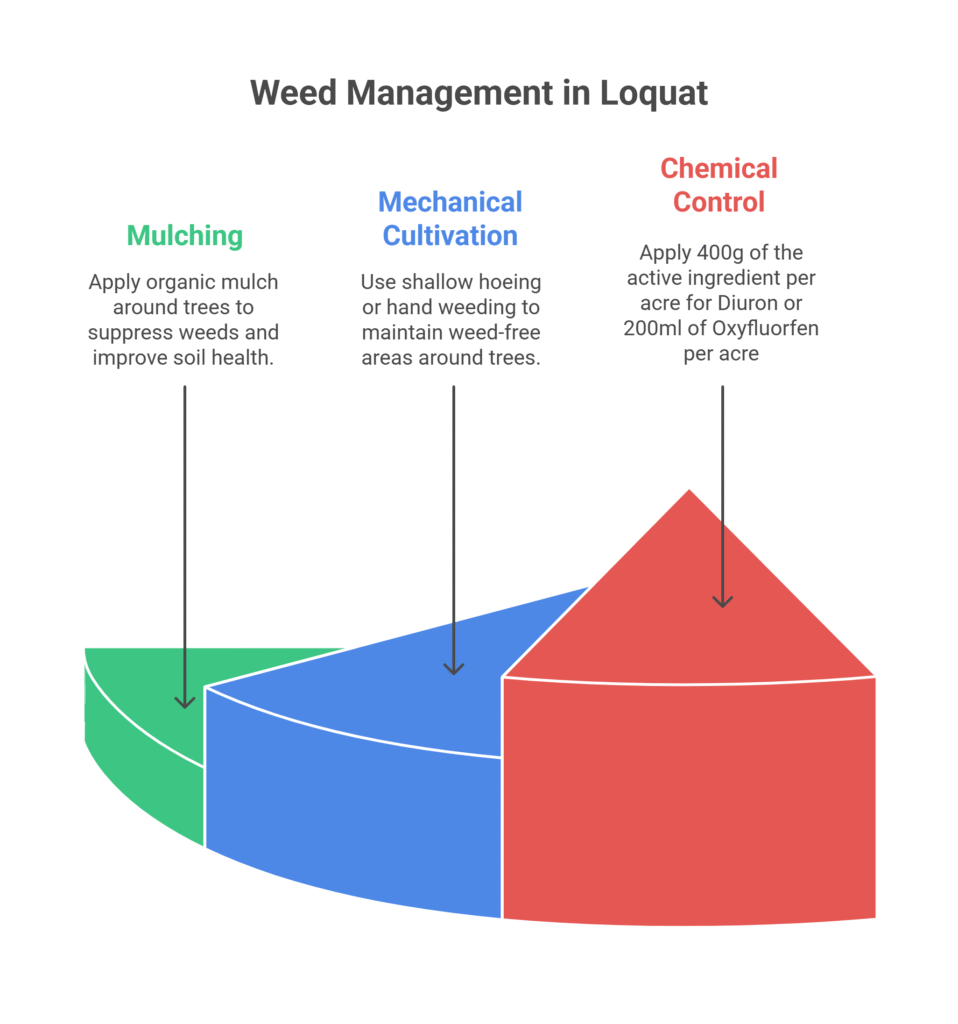
Mechanical Cultivation
Shallow hoeing or hand weeding is suitable for maintaining weed-free conditions within the basin area around each tree. Care should be taken to avoid deep cultivation, as it can damage feeder roots located near the soil surface.
Chemical Control (Herbicides)
To prevent harm to the loquat tree, herbicides should only be applied in extreme cases and with great care. When applying glyphosate, use 600 milliliters per acre and make sure the spray doesn’t come into touch with the green bark, leaves, or tree trunk.
For pre-emergent management, clean, weed-free soil beneath the canopy, with no contact with the trunk, can be treated with 400g of the active ingredient per acre for Diuron or 200ml of Oxyfluorfen per acre. Wear protective clothing at all times, and carefully read the label’s directions for safe and efficient use.
Inter Culture Operation (Training and Pruning)
Training
Young loquat trees should be trained to an open center or modified central leader system. This training structure helps ensure adequate light penetration and air circulation within the canopy, which is essential for healthy growth and fruit development.
Pruning Objectives
Pruning is carried out to remove dead, diseased, or damaged wood, thin out overcrowded branches, and maintain the tree’s shape and manageable size. It also involves removing water sprouts and suckers, improving light penetration, and encouraging new shoot growth, as loquats bear fruit on one-year-old wood.
Timing
Pruning is best done right after harvest, which is usually in late spring or early summer. Steer clear of severe trimming in late fall or early winter as this could encourage delicate new growth that is susceptible to freezing. However, throughout the year, light corrective pruning can be carried out as needed.
Pruning Method
Use sharp, clean tools to make cuts close to the branch collar without leaving stubs. Prioritize thinning cuts over heading cuts to open up the canopy and maintain good airflow. The goal is to keep the center of the tree open for maximum light exposure.
Flowering and Fruit Management
Flowering
Loquat trees typically flower during the autumn to winter months (October to February in the Northern Hemisphere). The flowers are fragrant, white, and appear in panicles. Since flowering occurs during cooler months, frost protection is crucial—methods such as overhead sprinklers, wind machines, or protective covers can help safeguard blooms from frost damage.
Pollination
Loquats are generally self-fertile, but cross-pollination significantly enhances fruit set, size, and overall quality. Bees play a vital role as natural pollinators. Planting multiple compatible cultivars near each other can further improve pollination and yields.
Fruit Thinning
Thinning is essential for promoting consistent yields and larger, better-quality fruits.
- Timing: Perform thinning after natural fruit drop, usually when fruits reach marble size—approximately 6–8 weeks after flowering.
- Method: Remove small, misshapen, or damaged fruits, leaving 1–3 healthy fruits per cluster, spaced 10–15 cm (4–6 inches) apart. Use clean scissors or carefully snap off by hand.
- Purpose: Reduces excess fruit load, minimizes branch stress, and improves fruit size, color, sweetness, and overall marketability.
Pest and Disease Management
Common Pests
Fruit Fly (e.g., Mediterranean, Oriental Fruit Fly)
Fruit flies, particularly Mediterranean and Oriental species, are among the most damaging pests in loquat cultivation, leading to internal fruit damage and premature fruit drop.
Effective management involves an integrated approach that includes field sanitation by regularly removing and destroying fallen or infested fruits, bagging developing fruits, and harvesting on time to prevent infestation.
Bait sprays can be used by mixing 20 ml of Malathion 50 EC with 200 g of jaggery or protein hydrolysate in 10 liters of water, applied as a spot spray on foliage (avoiding direct contact with fruits).
Additionally, methyl eugenol or cue lure traps should be installed at a density of 8–10 traps per acre to monitor and reduce adult populations.
In cases of severe infestation, Spinosad 45 SC can be applied at 0.3 ml per liter of water as a targeted spot spray, but insecticides should be used sparingly to protect pollinators and beneficial insects.
b) Aphids and Scale Insects
Loquat plants are weakened by sap-sucking pests like aphids and scale insects, which consume plant fluids and release honeydew, which promotes the formation of sooty mold and inhibits photosynthesis.
Aphids usually infest the undersides of leaves and young shoots, whereas scale insects cling to stems and branches. Contact sprays of insecticidal soap or 2% horticultural oils can be used to control early infestations.
Chemical control using Imidacloprid 17.8 SL at 0.3 ml per liter of water or Thiamethoxam 25 WG at 0.25 g per liter works well for more serious instances. Encouraging natural predators like lacewings and ladybird beetles can also help maintain biological control over the long run.
Birds
Birds such as mynas, bulbuls, and parrots can inflict considerable damage on ripening loquat fruits by pecking, leading to reduced market value and yield loss. To protect the crop, bird netting should be used to physically exclude birds from the trees during the ripening period.
Additional measures include deploying visual and auditory scare devices like reflective tape, scarecrows, or motion-activated alarms. For continued effectiveness, it is important to regularly rotate or reposition these deterrents to prevent birds from becoming accustomed to them.
d) Caterpillars (e.g., Leaf Rollers)
Caterpillars, such as leaf rollers, are destructive pests in loquat orchards that feed on leaves and developing fruits by rolling foliage and boring into the fruit, resulting in yield loss and reduced fruit quality.
In smaller orchards, mechanical control through handpicking and destroying infested leaves and visible larvae can be effective. For biological control, spraying Bacillus thuringiensis (Bt) at a rate of 1–2 g per liter of water is recommended, especially during the early larval stages.
If infestation levels remain high, chemical control may be necessary using Emamectin Benzoate 5 SG at 0.4 g per liter or Lambda-Cyhalothrin 5 EC at 0.5 ml per liter. These sprays should be applied during evening hours to reduce harm to beneficial insects.
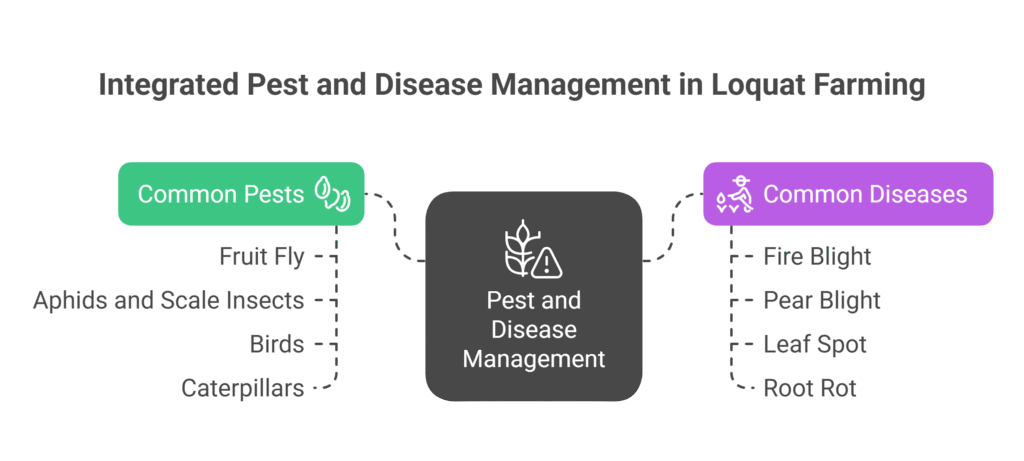
Common Diseases
Fire Blight (Erwinia amylovora)
A dangerous bacterial disease called fire blight results in gushing cankers, withered blooms, and charred stalks. Pruning diseased branches as soon as possible, at least 30 to 60 cm below the symptoms, is the best way to control it.
To prevent the bacteria from spreading, sanitize pruning instruments in between cuts. Because it encourages sensitive, vulnerable tissue, avoid fertilizing with too much nitrogen when the plant is actively growing.
Although chemical treatment of bacterial illnesses is challenging, applied during early bloom and wet conditions, copper-based sprays, such as Copper Oxychloride at 2.5–3 g per liter of water, may provide only a limited level of protection.
Pear Blight (Pseudomonas syringae)
Pear blight leads to blossom blast and twig dieback, often appearing during cold, wet conditions. Management includes applying copper sprays during dormancy and again in autumn to reduce bacterial load. Use Copper Hydroxide at 2–3 g per liter of water or Copper Oxychloride at similar doses for preventive control. Avoid overhead irrigation and pruning during wet conditions.
Leaf Spot (Cercospora spp. and others)
Leaf spot diseases are fungal infections that produce brown or black spots on loquat leaves, leading to premature defoliation. Improve air circulation, avoid overhead irrigation, and remove fallen, infected leaves to reduce inoculum. For chemical control in severe cases, apply Mancozeb 75% WP at 2.5 g per liter of water or Copper Oxychloride at 3 g per liter at 10–15-day intervals during humid weather.
Root Rot (Phytophthora spp.)
Root rot is commonly associated with poorly drained soil and waterlogged conditions, causing root decay and plant decline. Improve soil drainage and avoid over-irrigation to prevent disease. Use resistant rootstocks if available. Fungicides are preventive only, not curative. Drench soil with Metalaxyl 35% WS at 2 g per liter or Fosetyl-Al 80% WP at 2.5 g per liter as a precautionary measure during the rainy season.Bottom of Form
Harvesting
Loquat fruits should be harvested when fully ripe, as they do not ripen well after picking. Ideal maturity is indicated by a deep yellow to orange color (depending on the cultivar), slight softness at the blossom end, and easy detachment from the branch with a gentle upward twist—avoid harvesting green fruits.
The typical harvesting season falls in spring (April to June in the Northern Hemisphere), lasting 2 to 6 weeks based on the cultivar and climate, with multiple pickings required as the fruit ripens unevenly. Harvesting should be done by hand, carefully including the stem to prevent bruising, and using padded containers to protect the fruit.
It is best to harvest during the cooler parts of the day. As loquats are highly perishable, handle them gently, cool them immediately after harvest, and store at 0–5°C (32–41°F) with 90–95% relative humidity. Avoid temperatures below 0°C to prevent chilling injury.
Yield
| Tree Age | Per Tree Yield | Per Acre Yield |
| Young Trees (4–6 yrs) | 5–15 kg per tree | 560 – 1,680 kg per acre |
| Mature Trees (8–10+ yrs) | 20–50 kg per tree | 2– 5 tonnes per acre |
Cost of Investment per acre for Loquat Farming
| S.N. | Cost Category | Amount (NRs.) |
| 1 | Land Preparation (Plowing) | 15,000 |
| 2 | Plant Saplings (112 plants) | 28,000 |
| 3 | Pit Digging | 7,000 |
| 4 | Planting | 5,000 |
| 5 | Fertilizers and Manure | 27,000 |
| 6 | Irrigation | 20,000 |
| 7 | Weed Control (Pre & Post-emergence) | 5,000 |
| 8 | Pest & Disease Control | 7,000 |
| 9 | Miscellaneous Costs | 10,000 |
| Total Initial Investment (Year 1) | 124,000 |
Annual maintenance cost per acre for Loquat Farming
From the second year onward, the annual maintenance cost for loquat farming is estimated at around NRs. 50,000 per acre. This recurring expense typically includes the cost of irrigation, application of fertilizers and manure, pest and disease management, weed control, pruning and training of trees, labor charges, and other routine orchard care activities necessary to maintain tree health and ensure good yield. Proper and timely investment in these maintenance practices is essential for sustaining productivity and maximizing profits over the orchard’s lifespan.
Annual Yield & Income Projection Per Acre Per Year
| Year Range | Yield/Tree (kg) | Yield/Acre (kg) | Price (NRs/kg) | Annual Income (NRs) |
| 4th Year | 3 | 336 | 120 | 40,320 |
| 5th Year | 7 | 784 | 120 | 94,080 |
| 6th Year | 12 | 1,344 | 120 | 161,280 |
| 7-15 Year (Peak) | 25 | 2,800 | 120 | 336,000 |
| 16-20 Year | 15 | 1,680 | 140 | 235,200 |
| 21+ Year | 10 | 1,120 | 140 | 156,800 |
Analysis of Loquat Farming Profit Per Acre
| Year | Income (NRs) | Costs (NRs) | Net Cash Flow (NRs) | Cumulative Profit (NRs) |
| 1 | 0 | 124,000 | -124,000 | -124,000 |
| 2 | 0 | 50,000 | -50,000 | -174,000 |
| 3 | 0 | 50,000 | -50,000 | -224,000 |
| 4 | 40,320 | 50,000 | -9,680 | -233,680 |
| 5 | 94,080 | 50,000 | 44,080 | -189,600 |
| 6 | 161,280 | 50,000 | 111,280 | -78,320 |
| 7 | 336,000 | 50,000 | 286,000 | 207,680 |
| 8 | 336,000 | 50,000 | 286,000 | 493,680 |
| 9 | 336,000 | 50,000 | 286,000 | 779,680 |
| 10 | 336,000 | 50,000 | 286,000 | 1,065,680 |
| 11 | 336,000 | 50,000 | 286,000 | 1,351,680 |
| 12 | 336,000 | 50,000 | 286,000 | 1,637,680 |
| 13 | 336,000 | 50,000 | 286,000 | 1,923,680 |
| 14 | 336,000 | 50,000 | 286,000 | 2,209,680 |
| 15 | 336,000 | 50,000 | 286,000 | 2,495,680 |
| 16 | 235,200 | 50,000 | 185,200 | 2,680,880 |
| 17 | 235,200 | 50,000 | 185,200 | 2,866,080 |
| 18 | 235,200 | 50,000 | 185,200 | 3,051,280 |
| 19 | 235,200 | 50,000 | 185,200 | 3,236,480 |
| 20 | 235,200 | 50,000 | 185,200 | 3,421,680 |
| 21 | 156,800 | 50,000 | 106,800 | 3,528,480 |
| 22 | 156,800 | 50,000 | 106,800 | 3,635,280 |
| 23 | 156,800 | 50,000 | 106,800 | 3,742,080 |
| 24 | 156,800 | 50,000 | 106,800 | 3,848,880 |
| 25 | 156,800 | 50,000 | 106,800 | 3,955,680 |
The loquat orchard reaches its break-even point in Year 7, where cumulative profit turns positive. The peak earning phase spans Years 7–15, generating 72% of the total income. The total investment includes an initial cost of NRs 124,000 and maintenance costs of NRs 1,200,000 (NRs 50,000 annually for 24 years), resulting in total costs of NRs 1,324,000 over 25 years. Against this, total income amounts to NRs 5,279,680, yielding a net profit of NRs 3,955,680. This translates to an annualized profit of approximately NRs 219,760/year from Year 7 onward.
Sources
Food and Agriculture Organization (FAO)
University of California Agriculture & Natural Resources (UC ANR)
Nepal Agricultural Research Council (NARC)
Punjab Agricultural University (PAU)
Tamil Nadu Agriculture University (TNAU) – Agritech portal
Indian Council of Agricultural Research (ICAR)

